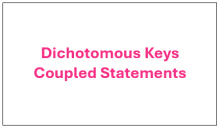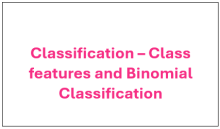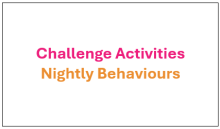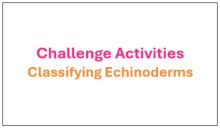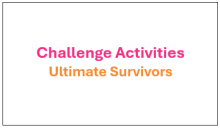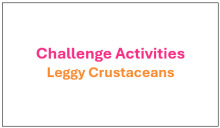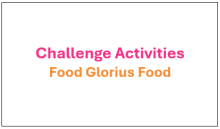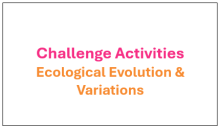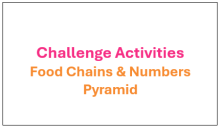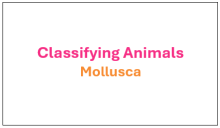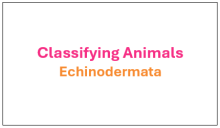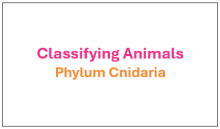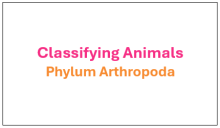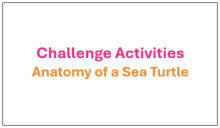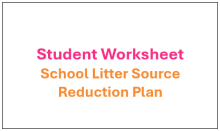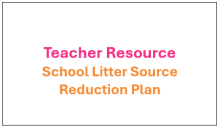- All pages
- Primary school
- Middle school
- Senior school
Middle/Senior Grade 7 to 11 - Identifying Animal Phyla
Dichotomous Keys - Coupled Statements
Dichotomous Keys use coupled statements about key features that an animal may possess to help identify it.
1. Using the key below determine which phylum each animal at the bottom of the page belongs to. First select an animal, then beginning at statement one, work through all
statements until you find the one that best fits that animal.
2. Record the phylum for each animal below its image.
Senior Grade 11 - Class features and Binomial Classification
Classification
1. Class features - Using the information from page 1, find examples of reef animals for each of the Classes to
complete the table below. Include the Genus and species name for each animal if you can. In
the last column, record the features of the animal that group it in this Class.
2. What’s in a name?
a. Explain how we can tell they are different species if they have the same species name?
b. Investigate what the word “lineatus” means. Record your findings below.
c. Explain why both fish have the same species name of lineatus?
Senior Grade 11 - Phylum Features Table
Classification
1. Complete the table below using the information on Page 2 to help you.
2. This table lists the common features or characteristics that are used to group
animals into different Phyla. Use this information to help you to complete the
table.
Primary Grade 5 - (Behavioural) Nightly Behaviours
Reef animals have some unusual behaviours at night.
Can you guess what they are?
Middle/Senior Grade 7 to 11 - Platyhelminthes
Classification - Phylum Platyhelminthes
1. Select which group of worms the name Platyhelminthes refers to.
2. Connect the following words to their meaning.
3. Identify the key characteristics of animals in this phylum.
Middle Grade 7 - What makes them different?
Classification Challenge Sheet Echinoderms
1. What makes them different? SeaStar, sea cucumbers and sea urchins are all grouped together because they have characteristics in common, even though each animal looks very different to the others.
2. List three characteristics that they all have in common.
3. Dichotomous keys are used by scientists to correctly identify species. Use the key below to identify the three types of echinoderms in the pictures below.
Pagination
Primary Grade 5 - Ultimate Survivor
Adaptations
1. Design the ultimate reef creature animal species name.
2. Draw your creature!
a) Would an animal with a shark's body, jellyfish tentacles and stonefish camouflage be the ultimate survivor on a coral reef?
b) Using what you already know, and the information on page 2, create your own Ultimate Reef Creature. Make sure to name your creation and list it’s adaptations in the boxes below, then draw what your creature would look like.
c) Pick your favourite reef creature and tick the adaptations they possess from the list below.
Primary Grade 5 -Leggy Crustaceans
Adaptations
Crustaceans have adapted their jointed, armoured legs so that they can be used not just for walking over sand and coral, but for swimming, feeling, catching and grasping food, holding bunches of eggs and even for shooting backwards.
1. Using the letters in this table, colour in the legs as indicated and find out uses of the different legs on each of these crustaceans. Some legs may be used for more than one action.
Primary Grade 5 - Food Glorius Food
Adaptations
1. Use the information on page 2 to help you complete the table below as you explore animal shapes, habitats and special features. Explore animal shapes, habitats and special features.
An animal’s mouth and body shape, as well as the habitat it lives in can give us clues as to what it feeds upon. Many marine organisms also possess defence mechanisms to prevent them from becoming food themselves.
2. Use the information below to assist you in completing the table on the previous page.
Primary Grade 5 - Ecological Evolution & Variations
Adaptations
1. How do corals compete for light? Reef building corals require solar energy to grow and lay down their skeleton.
2. Your challenge is to investigate the structural adaptations that corals have evolved to compete for this valuable resource.
3. Use the information gained to complete the table below.
Primary Grade 4 - Seagrass Beds
Seagrass meadows are important ecosystems in the Great Barrier Reef Marine Park.
Colour all the animals you can find and then answer the following questions.
1. Identify as many organisms as you can and record their names below:
2. Define the following terms: a. Producer b. Consumer c. Decomposer
3. Identify an organism in a seagrass meadow that is a: a. Producer b. Consumer c. Decomposer
Primary Grade 4 - Food Chains & Numbers Pyramid
1. Consider the following levels in a food chain. Write examples of the plants or animals that represent each level in a marine food chain environment.
2. Food chains vary in length though are rarely more than five levels. Suggest a reason for this.
3. Food webs give a useful description of the feeding relationships in an ecosystem.
a. Using the examples you have written in the table above, draw a pyramid of numbers which represents this food chain.
b. Draw a pyramid of numbers that represents the following scenario: a large predatory fish covered in parasites, being cleaned by a symbiotic cleaner fish.
Pagination
Middle/Senior Grade 7 to 11 - Mollusca
Classification - Phylum Mollusca
1. List some of the animals that belong in this phylum.
2. Identify the key characteristics of animals in this phylum.
3. Describe what a radula is and where it is found.
Middle/Senior Grade 7 to 11 - Echinodermata
Classification - Phylum Echinodermata
1. List the five (5) main classes (groups) of animals in this phylum.
2. Identify the key characteristics of animals in this phylum.
3. Describe papulae and explain what they are used for.
4. Describe a madreporite and explain what it is used for.
Middle/Senior Grade 7 to 11 - Cnidaria
Classification - Phylum Cnidaria
1. Name three animals that belong to the phylum Cnidaria.
2. Identify the key characteristics of Cnidarians.
3. Describe what nematocysts are used for.
Middle/Senior Grade 7 to 11 - Arthropoda
Classification - Phylum Arthropoda
1. List some animals that belong to this phylum.
2. Identify the key characteristics of animals in this phylum.
3. Describe what an exoskeleton is.
Middle/Senior Grade 7 to 11 - Annelida
Classification - Phylum Annelida
Annelids are also known as segmented worms. They are extremely variable in form and lifestyle and live in all ecosystems on Earth.
1. List four animals that belong to the phylum Annelida.
2. The name ‘Polychaete’ (pronounced ‘polly-keet’) comes from the Greek words “poly” and “chaeta”. What do these names mean?
3. Using the key below, label the features of the polychaete.
Primary/Middle Grade 2-7
Use the words in the box below to label the parts of the Sea Turtle.
Pagination
Middle/Senior Grade 7 to 11 - Echinodermata
Classification - Phylum Echinodermata
1. List the five (5) main classes (groups) of animals in this phylum.
2. Identify the key characteristics of animals in this phylum.
3. Describe papulae and explain what they are used for.
4. Describe a madreporite and explain what it is used for.
Middle/Senior Grade 7 to 11 - Cnidaria
Classification - Phylum Cnidaria
1. Name three animals that belong to the phylum Cnidaria.
2. Identify the key characteristics of Cnidarians.
3. Describe what nematocysts are used for.
Middle/Senior Grade 7 to 11 - Arthropoda
Classification - Phylum Arthropoda
1. List some animals that belong to this phylum.
2. Identify the key characteristics of animals in this phylum.
3. Describe what an exoskeleton is.
Middle/Senior Grade 7 to 11 - Annelida
Classification - Phylum Annelida
Annelids are also known as segmented worms. They are extremely variable in form and lifestyle and live in all ecosystems on Earth.
1. List four animals that belong to the phylum Annelida.
2. The name ‘Polychaete’ (pronounced ‘polly-keet’) comes from the Greek words “poly” and “chaeta”. What do these names mean?
3. Using the key below, label the features of the polychaete.
Student Worksheet - School Litter Source Reduction Plan
Student Worksheet - School Litter Source Reduction Plan
Teachers Resource - School Litter Source Reduction Plan
This tool may assist Teachers to complete the worksheet.

